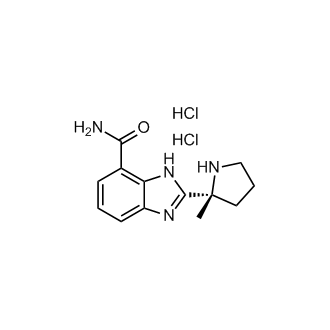| Size | Price | Stock |
|---|---|---|
| 5mg | $60 | In-stock |
| 10mg | $84 | In-stock |
| 50mg | $240 | In-stock |
| 100mg | $384 | In-stock |
| 200mg | $624 | In-stock |
| 500 mg | Get quote | |
| 1 g | Get quote | |
| We match the lowest price on market. | ||
We offer a substantial discount on larger orders, please inquire via [email protected]
or Fax: (86)21-58955996
Inquiry for price and availability only. Please place your order via our email or fax.
| Cat. No. : | HY-10130 |
| M.Wt: | 317.21 |
| Formula: | C13H18Cl2N4O |
| Purity: | >98 % |
| Solubility: | DMSO : ≥ 3.2 mg/mL (10.09 mM); H2O : 250 mg/mL (788.12 mM; Need ultrasonic) |
Veliparib (dihydrochloride) is a potent inhibitor of PARP1 and PARP2 with Kis of 5.2 nM and 2.9 nM in cell-free assays, respectively. IC50 & Target: Ki: 5.2 nM (PARP1), 2.9 nM (PARP2)[1] In Vitro: Veliparib is inactive to SIRT2 (>5 μM)[1]. Veliparib inhibits the PARP activity with EC50 of 2 nM in C41 cells[2]. Veliparib can decrease the PAR levels in both irradiated and nonirradiated H460 cells. Veliparib reduces clonogenic survival and inhibits DNA repair by PARP-1 inhibition in H460 cells. Veliparib increases apoptosis and autophagy in H460 cells when combination with radiation[3]. Veliparib inhibits PARP activity in H1299, DU145 and 22RV1 cells and the inhibition is independent of p53 function. Veliparib (10 μM) suppresses the surviving fraction (SF) by 43% in the clonogenic H1299 cells. Veliparib shows effective radiosensitivity in oxic H1299 cells. Veliparib can attenuate the SF of hypoxic-irradiated cells including H1299, DU145 and 22RV1[4]. In Vivo: The oral bioavailability of Veliparib is 56%-92% in mice, SD rats, beagle dogs, and cynomolgus monkeys after oral administration[1]. Veliparib (25 mg/kg, i.p.) can improve tumor growth delay in a NCI-H460 xenograft model. Combination with radiation, veliparib decreases the tumor vessel formation[3]. Veliparib reduces intratumor PAR levels by more than 95% at a dose of 3 and 12.5 mg/kg in A375 and Colo829 xenograft models and the suppression can be maintained over time[4].
Lorem ipsum dolor sit amet, consectetur adipisicing elit. Autem earum hic iste maiores, nam neque rem suscipit. Adipisci consequatur error exercitationem fugit ipsam optio qui, quibusdam repellendus sed vero! Debitis.
Inquiry Information- Product Name:
- Veliparib (dihydrochloride)
- Cat. No.:
- HY-10130
- Quantity:


Your information is safe with us.